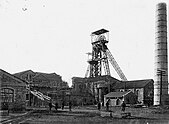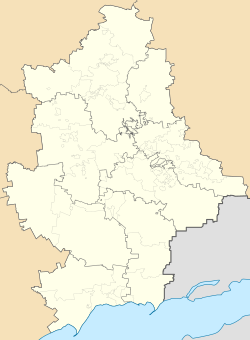Bunhe
Bunhe/Bunge
Бунге/Бунґе Yunokomunarivsk | |
|---|---|
City | |
| Coordinates: 48°13′14″N 38°16′26″E / 48.22056°N 38.27389°E | |
| Country | |
| Oblast | Donetsk Oblast |
| Raion | Horlivka Raion |
| Hromada | Yenakiieve urban hromada |
| Founded | 1908 |
| City rights | 1965 |
| Population (2022) | |
• Total | 13,495 |
| Climate | Dfb |
 | |

Bunhe, also Bunge (Ukrainian: Бунге/Бунґе; Russian: Бунге, romanized: Bunge), also known as Yunokomunarivsk (Ukrainian: Юнокомунарівськ; Russian: Юнокоммунаровск), is a city in Yenakiieve urban hromada, Horlivka Raion, Donetsk Oblast (province) of Ukraine. Population: 13,495 (2022 estimate)[1], 14,154 (2013 est.)[2], 17,813 (2001).
Geography
[edit]Bunge is located near the Yenakiieve railway station on the Bulavynka River (tributary of Krynka, Mius Basin). The surface is wavy, dissected by ravines and gullies. The elevation is up to 200 meters.[3]
History
[edit]It was founded in 1908 when the Russian-Belgium Metallurgical Association founded Bunge mine to supply coal to Petrovskiy steelworks (now Yenakiieve Iron and Steel Works). The name Bunhe or Bunge comes from the German surname Bunge.[citation needed]
In 1924, the Yunkom coal mine was named "Yunkom" ("Yuny communar"; Ukrainian: Young communist) and the settlement was named "Yunokomunarivsk". In 1965 it received urban-type settlement status. On 16 September 1979, in the mine "Yuny Communar" there was one of the Nuclear Explosions for the National Economy—an object "Klivazh". In 2002 the mine was closed as non-perspective and ecologists worried about the danger of filling the mine with water. It might cause radioactive pollution of the underground water, so pumps continue to pump water out of the abandoned mine.[4][5]
During the war in Donbas the city was captured by the widely unrecognized Donetsk People's Republic (DPR). On 21 September 2014 Ukrainian forces left Yunokomunarivsk.[6]
On 12 May 2016, the Verkhovna Rada renamed Yunokomunarivsk back to its original name Bunhe (Ukrainian: Бунге or Бунґе) to conform to the law prohibiting names of Communist origin.[7] however they couldn't enforce it on the city since it was under separatist control.
In 2018 the administration of the DPR decided to flood the Yunkom coal mine. The drainage required maintenance of water pumps, which stopped along with the region's general infrastructure degradation after the Russian military occupation.[8][9] The information was confirmed by OSCE Monitoring Mission.[10] In April 2018 the DPR removed water pumps from the Yunkom mine, so it is gradually flooded by the natural waters. The radiological contamination was viewed as potentially spreading to the Mius River and then to the Azov Sea, threatening drinking and irrigation water supplies.[11]
In 2023 the city as well as other parts of the DPR were annexed by Russia after a mostly unrecognized referendum.
Demographics
[edit]As of the Ukrainian national census in 2001, the settlement counted a population of 17,828 people. In terms of ethnicity, 55% of the population claimed to have an ethnic Russian background, which is the highest percentage recorded in any major settlement in the entire Donetsk Oblast. The second-largest group were Ukrainians, follwed by Belarusians, Tatars and Azerbaijanis. The exact ethnic compsition was as follows:[12]
Native language as of the Ukrainian Census of 2001:[13]
Notes
[edit]- ^ Чисельність наявного населення України на 1 січня 2022 [Number of Present Population of Ukraine, as of January 1, 2022] (PDF) (in Ukrainian and English). Kyiv: State Statistics Service of Ukraine. Archived (PDF) from the original on 4 July 2022.
- ^ Чисельність наявного населення України [Actual population of Ukraine] (in Ukrainian). State Statistics Service of Ukraine. Archived from the original on 2014-02-02. Retrieved 21 January 2015.
- ^ Юнокомунарівськ (in Ukrainian). Географічна енциклопедія України. 1993. p. 456.
- ^ "An environmental disaster looms in war-torn Ukraine". NBC News. 2021-05-16. Retrieved 2023-09-18.
- ^ Про заходи щодо розв'язання еколого-гідрогеологічних проблем, які виникають унаслідок закриття гірничо-видобувних підприємств, шахт і розрізів. За матеріалами доповіді Міністра екобезпеки Василя Шевчука на засіданні Кабінету міністрів України 11 січня 1999 року
- ^ "Кабмін назвав міста Донбасу, підконтрольні сепаратистам". Korrespondent.net (in Ukrainian). Retrieved 2023-10-05.
- ^ "ВР перейменувала низку населених пунктів у зоні АТО на непідконтрольній Україні території Донбасу у рамках декомунізації". Інтерфакс-Україна (in Ukrainian). Retrieved 2020-06-21.
- ^ ""ДНР" збирається затопити шахту, де СРСР провів ядерний вибух". Главком (in Ukrainian). 2018-03-24. Retrieved 2023-09-18.
- ^ "Держдеп США стурбований інформаціією про наміри бойовиків затопити "ядерну" шахту на Донбасі". Український тиждень (in Ukrainian). 2018-04-14. Retrieved 2023-09-18.
- ^ "Latest from the OSCE Special Monitoring Mission to Ukraine (SMM), based on information received as of 19:30, 11 April 2018". OSCE. 2018-04-11. Retrieved 2023-09-18.
- ^ "Тема дня. Из-за шахты Юнком Азовское море может стать мертвым". LIGA (in Russian). 2018-04-24. Retrieved 2023-09-18.
- ^ "Національний склад міст".
- ^ "Офіційна сторінка Всеукраїнського перепису населення". Ukrcensus.gov.ua. Retrieved 2022-03-16.
References
[edit]- Пірко, Василь (1998). Заселення Степової України в XVI—XVIII ст (PDF) (in Ukrainian). Донецьк: Укр. центр. p. 124. Archived from the original (PDF) on 14 February 2017.
- Лаврів, Петро (1995). Моя земля — земля моїх батьків (in Ukrainian). Донецьк: Донецьке обласне Товариство української мови ім. Тараса Шевченка Український культурологічний Центр. Archived from the original on 20 December 2016.
- Пірко, Василь (2003). Заселення Донеччини у XVI—XVIII ст. (короткий історичний нарис і уривки з джерел) (PDF) (in Ukrainian). Донецьк: Східний видавничий дім: Український культурологічний центр. p. 180. Archived (PDF) from the original on 20 December 2016.
- Lavriv, Petro I. (1992). Istorija pivdenno-schidnoï Ukraïny (in Ukrainian). L'viv: Slovo. ISBN 978-5-8326-0011-6.
External links
[edit]- "История городов и сел Украины" (in Russian). Archived from the original on 16 June 2012.
- "Енакиево как на ладони" (in Russian).


